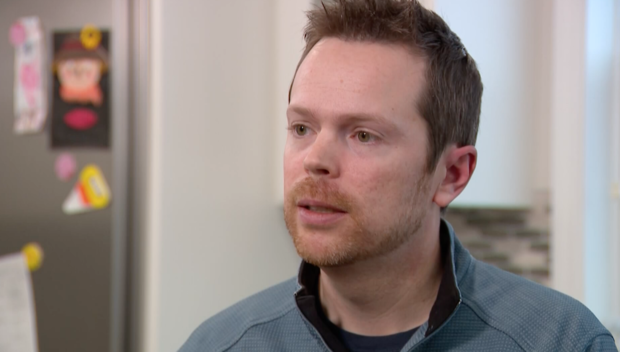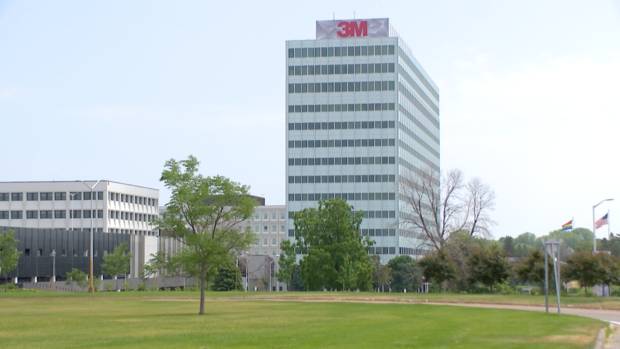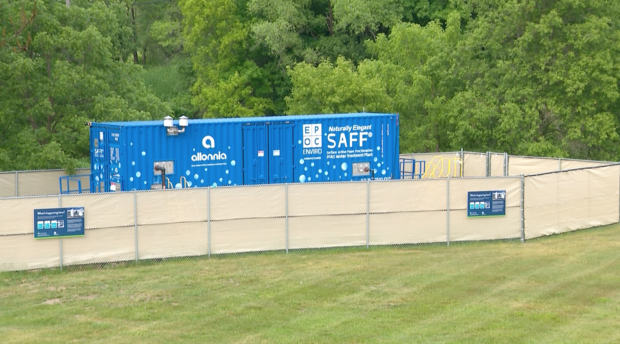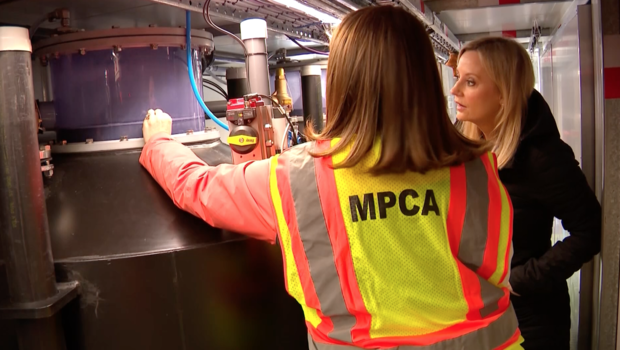PFAS in Minnesota: How "forever chemicals" changed the state of water
MINNEAPOLIS -- Minnesota is home to an abundance of natural resources - our incredible wealth of freshwater ranking number one for many.
With more than 69,000 miles of river, nearly 12,000 lakes, and more shoreline than Hawaii, California, and Florida combined, there's a lot to be proud of. But like many natural resources - pollution clouds the future.
For the last 20 years, Minnesota has been battling PFAS - toxic, synthetic chemicals that can invade the environment and have proved difficult to remove. The challenge is further complicated in the East Metro by 3M, one of several global companies that make PFAS, and is now attempting to remediate their impact.
Lake Elmo, Minnesota is one of the most affected areas and one of the fastest growing cities in the state.
The Environmental Protection Agency has released new guidance on safe levels of PFAS, guidelines which could impact the safety of drinking water around Minnesota.
While many new communities may be paying attention to the proposed guidelines and wondering what tighter restrictions could mean for them - other areas have been living with the impact of these chemicals for years.
Questions continue to be raised. Where did Minnesota's PFAS come from? How are they impacting our most precious resource? And what are we doing to protect our state of water?
RELATED: Report says nearly half the country's water contains PFAS
You've likely heard the acronyms PFAS and PFOS a lot more recently as Minnesota lawmakers look to outlaw their use in the state. PFAS is an abbreviation for polyfluoroalkyl substances -- a group of more than 5,000 harmful chemicals.
They're what's called forever chemicals, in everything from cosmetics to cookware and can now be widely detected in our water, soil, and air.
They have been shown to cause serious health problems like cancer and can affect child development.
Jeff Holtz and his family are among those who made the move to Lake Elmo.
It wasn't until after they settled into their new home that they learned about the PFAS in the drinking water.
"Lake Elmo is the epicenter, but it's impacting tens of thousands of families through no fault of their own," said Holtz.
He remembers his initial questions and concerns and can understand what new communities are going through.
"You have that worry in the back of your mind of what is going on, what are the risks. Do we need to do something ourselves," said Holtz.
As the EPA looks to tighten restrictions on what is considered safe drinking water, many people are left wondering – How did this happen? And just how far back do PFAS go in Minnesota?
In 2002 the state's Pollution Control Agency began seriously investigating the chemicals after 3M discovered groundwater contamination near an east metro plant.
By 2004, the Minnesota Department of Health had developed a method of testing tailored to the PFAS found at 3M's waste sites.
MDH began to see patterns emerge as concentrations, otherwise known as plumes. The chemicals were found near many waste disposal sites around the state, but scientists were particularly concerned about the size and severity in the east metro.
Now the Minnesota Pollution Control Agency knows that PFAS can enter the waste stream through three main waste sources: residential, commercial, and the biggest contributor - industrial. That waste then ends up in landfills, compost sites, and wastewater treatment plants.
According to experts, PFAS travel in complex paths through air, water, soil, and bedrock, often ending up in nearby groundwater.
The extraordinary durability of PFAS and added capacity to repel oil and water allows them to move with ease. It also makes them incredibly difficult to get rid of.
To better understand how this contamination occurs, the state MPCA conducted studies at closed landfills across Minnesota. What they discovered was troubling.
Out of 101 closed public waste sites, 98 of them were contaminated by PFAS. At 59 of those sites, the PFAS levels exceeded what was considered safe in drinking water.
In total, the MDH believes the drinking water supplies of over 140, 000 Minnesotans have been contaminated by high levels of PFAS.
In the east metro specifically, experts identified an area of groundwater contamination covering over 150 square miles. That's nearly three times the size of Minneapolis city limits. Lake Elmo lies at the epicenter.
In 2018, the state settled with 3M for $850 million dollars over its alleged damage to drinking water. 3M has since pledged to stop production of forever chemicals by 2025.
The MPCA says that while PFAS is a global issue, 3M's impact on the east metro stands apart in its scale and severity.
In a statement 3M said, "we will take responsibility where we are responsible."
3M says that PFAS are currently used in a variety of vital products used across many industries and companies. This includes healthcare, aerospace, automotive, and even firefighting foam. They insist that their products in these fields, including those with PFAS are safe and effective.
The manufacturing giant also says it is working to reduce contamination from facilities, clean up dump sites, as well as reduce the use of PFAS in its products.
Residents like Holtz also want to be part of the solution. He joined a work group that learned more about the forever chemicals and was involved in deciding where those 3M settlement dollars would go to mitigate the pollution and improve the drinking water.
He's now a city council member for Lake Elmo.
"There are ways to remedy it, but they do cost money," said Holtz.
That includes taking wells offline, installing new pipes to connect to water systems, adding filters, and more. With the water tested every quarter. He says information for communities is paramount.
"Data is going to be key to identifying where it's at, and then you can try to find the source and then you can look at solutions," he said.
The proposed guidelines by the EPA will change how people look at that data, and while the details are still being drafted, they're likely to have a big impact on certain communities.
So here's what you need to know:
The EPA's proposal is based on something called a maximum contaminant level which is the highest amount that a chemical is allowed to exist within drinking water and still be considered "safe."
MPCA acknowledges that some areas within the state do not currently meet those levels. After receiving the most recent water monitoring data the state health department named 14 areas that do not meet the proposed standards.
Those cities include Alexandria, Cloquet, Cottage Grove, Hastings, Lake Elmo, Pease, Saint Paul Park, Sauk Rapids, Stillwater, Swanville, Waite Park, and Woodbury. Wells in Austin and Rosevelt Court manufactured home parks were also included.
The MDH says that just because a city is on the list does not mean all its water is above the EPA's new PFAS limit, but that at least a portion exceeds it. The department also expects this list to grow as more testing takes place.
Both state and federal agencies say they hope to finalize the new standards by the end of 2023 but say it won't be enforced for another two to three years after that, possibly longer. Like any big change, it takes time.
Here at home - lawmakers have successfully banned non-essential PFAS in consumer products starting in 2025.
The new law - which was included in the state's omnibus bill - also requires stricter reporting of products that contain them and increased funding for clean-up.
Minnesota now has the strictest legislation on PFAS in the nation.
The Minnesota Pollution Control Agency has also been working hard on what could be a hopeful solution.
The state has been testing a way to remove and reduce PFAS from the environment at Tablyn Park in Lake Elmo - paid for with funds from the 3M settlement.
This blue trailer is called a SAFF, made in Australia, and one of only 20 in existence.
The technology is in high demand and Minnesota leads the charge as the first state government to purchase and implement it. WCCO had a chance to tour the facility.
According to MPCA hydrogeologist Rebecca Higgins, the process is somewhat simple.
The process works in two parts. First – It starts by pulling in water through the exterior pipes and going into the drums inside.
Then the water moves through venturi pumps which shoot air into the liquid creating foam.
The foam is then removed and PFAS levels are significantly reduced. In fact, MPCA says roughly 90% of PFAS in the treated water is extracted.
The PFAS foam then goes into something called a DEFLUORO unit - a second piece of technology that breaks down and destroys the chemicals.
While not all the PFAS are able to be removed, the MPCA says the residual water is returned to the environment both cleaner and safer.
Engineers are still fine tuning the right levels to get the best response.
"We want to protect human health and the environment to the degree we possibly can, to the degree the technology is capable of, to the degree that's reasonable," said Higgins.
Meanwhile in Lake Elmo, Holtz says he's optimistic about the steps agencies are taking to protect people.
"Residents deserve clean water. It is their right and families depend upon it, businesses depend upon it, schools, hospitals," said Holtz.
He says while his water is safe now, he knows the new EPA guidelines and evolving science could say otherwise, potentially changing how his community responds and the number of others impacted by PFAS.
"There's always the level of concern of what will the science say tomorrow. Where will the plume be moving to tomorrow. It's a balancing act of vigilance, with trying to stay informed," he said.
According to the MPCA it would cost up to $28 billion over the next 20 years to remove PFAS from the state's wastewater streams.
On June 22, 2023, 3M agreed to pay $10.3 billion to settle lawsuits surrounding "forever chemicals" in drinking water over the course of the next 13 years. The funds will be used for PFAS treatment technologies across the country.
3M says the settlement is "not an admission of liability."
State agencies encourage Minnesota residents to check on their own water sources. The MDH has created an interactive dashboard where you can look at your community and any contaminants recorded.
You can also sign up to have your water tested for PFAS by MPCA officials.
You can find access to these resources and more here.








